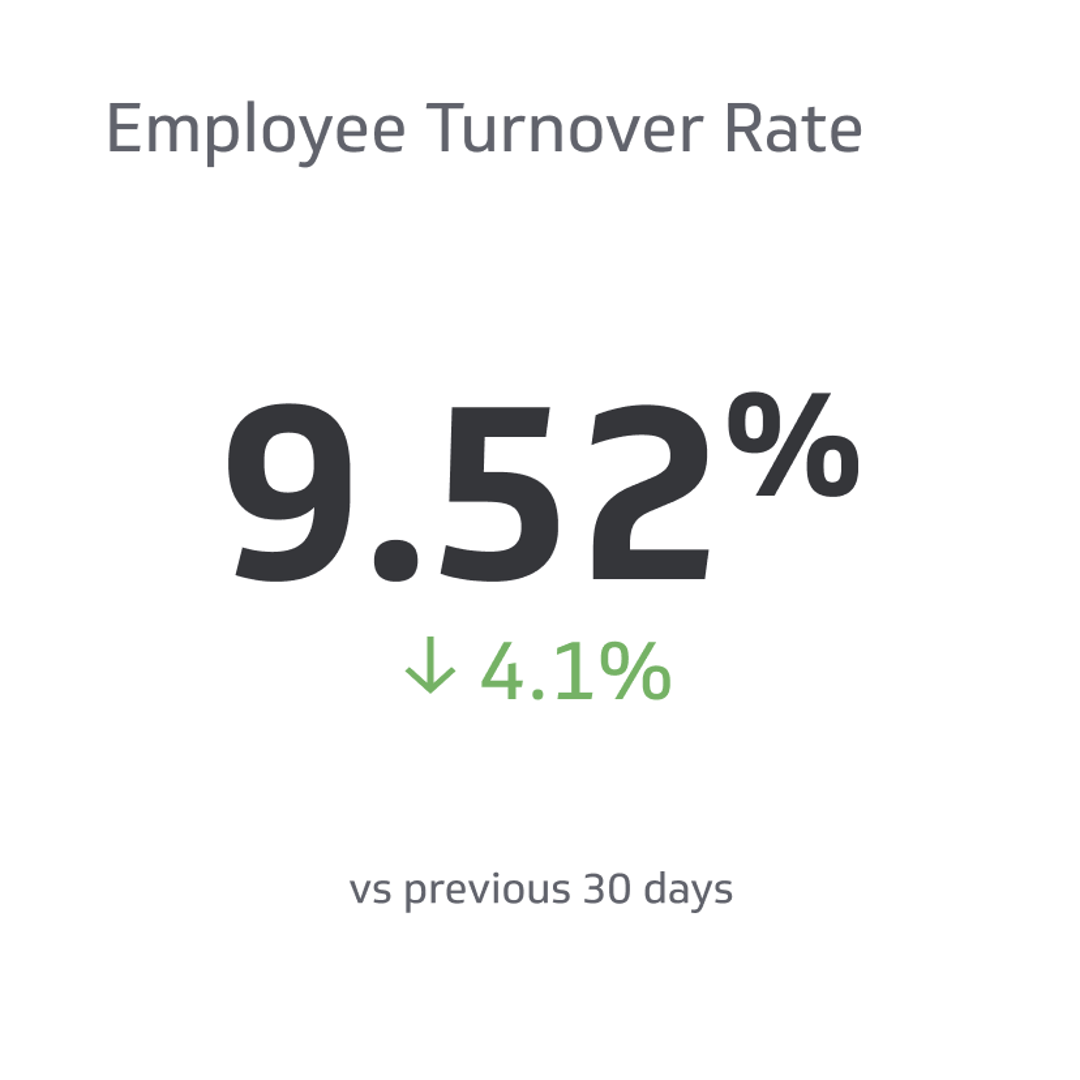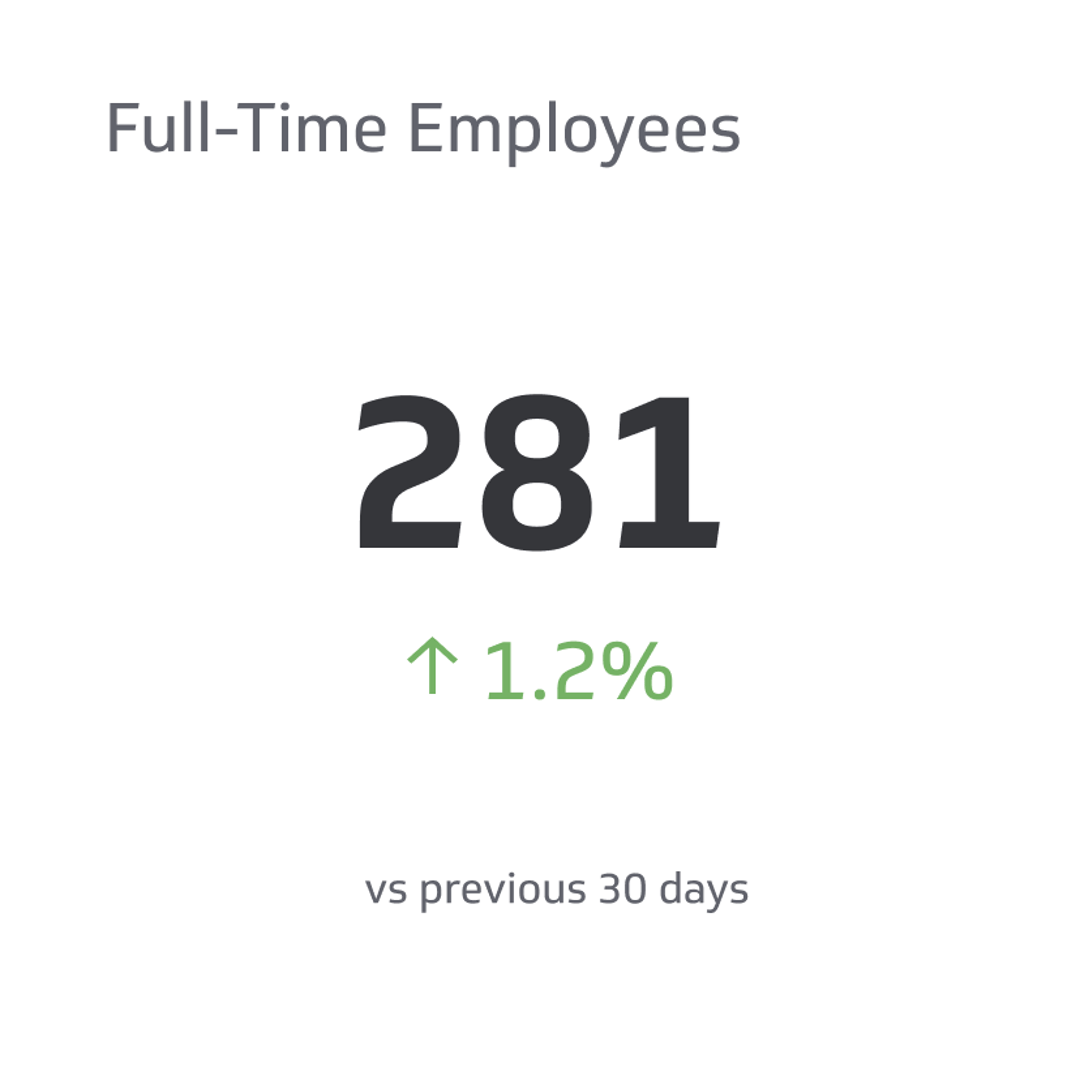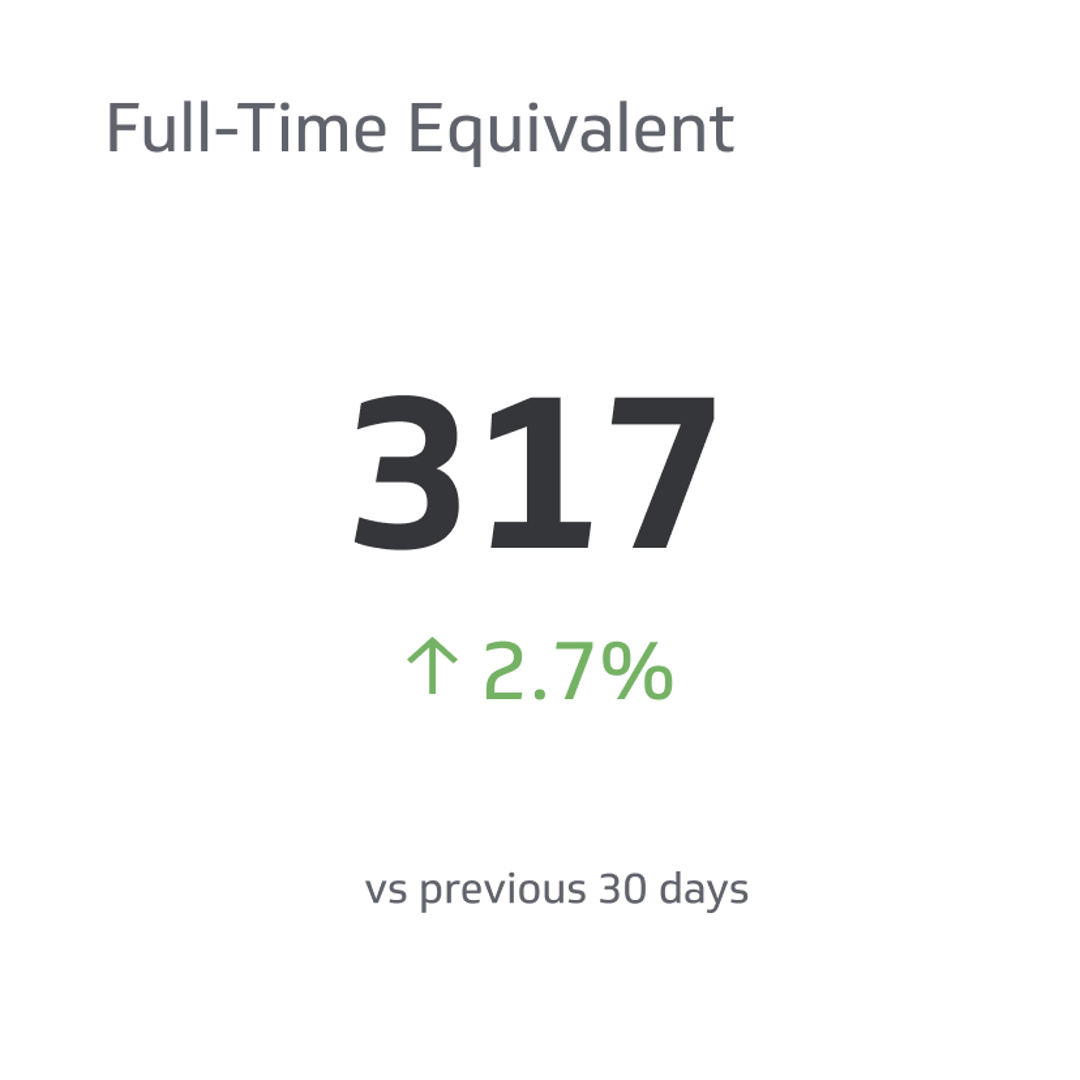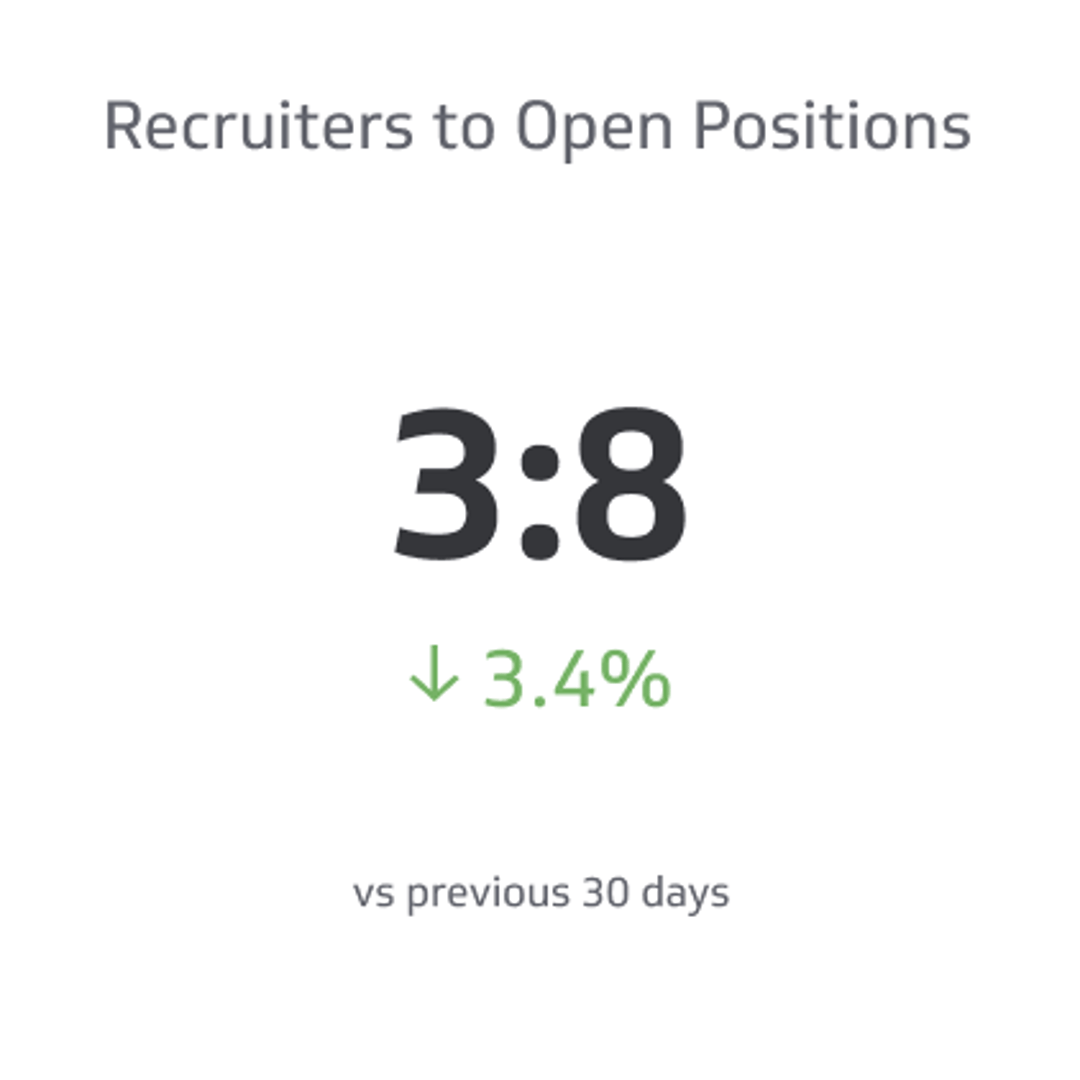Employee Turnover Rate
Employee turnover rate is a vital metric to quantify the frequency of employees leaving an organization over a specific period.
Track all your HR KPIs in one place
Sign up for free and start making decisions for your business with confidence.

In today's dynamic business landscape, measuring key metrics is vital for strategic decision-making and sustainable growth. One crucial metric is the Employee Turnover Rate, which indicates organizational health and employee satisfaction.
High turnover harms productivity, morale, and finances, while low turnover indicates stability and engagement. Thus, knowing the factors that drive turnover and measuring it accurately is vital for a productive work environment and long-term business success.
In this article, we'll explore the significance of this metric and the factors influencing turnover. So let's get started!
What Is Employee Turnover Rate?
Employee turnover rate is a vital metric to quantify the frequency of employees leaving an organization over a specific period. It offers valuable insights into the attrition levels and overall stability of a workforce.
By understanding this metric, businesses can identify potential issues, develop targeted retention strategies, and make well-informed decisions to optimize their human resources.
Voluntary vs. Involuntary Turnover
The overall turnover rate consists of two primary types: voluntary turnover and involuntary turnover, each contributing to the metric in distinct ways.
Voluntary turnover refers to employees who willingly choose to leave the organization. This type of turnover can arise from various reasons, such as job dissatisfaction or an unfavorable work environment.
On the other hand, involuntary turnover encompasses employees who are terminated or dismissed by the organization. Involuntary turnover can result from subpar performance, disciplinary problems, organizational restructuring, or economic circumstances.
Why Employee Turnover Matters
Employee turnover is not just a numerical metric. It has significant implications for organizations across various aspects of their operations. Understanding it helps you recognize the potential negative consequences and take proactive measures to mitigate them.
Extra Expense in Recruiting a Replacement
Whenever an employee leaves an organization, it incurs costs related to the recruitment, onboarding, and training of a new hire. These expenses can be significant, including job advertisements, recruitment agency fees, interviews, background checks, and orientation programs.
Thus, a high turnover rate can strain an organization's financial resources, making it difficult to allocate funds to other critical areas of operation.
Lower Morale for Those Who Are Left
Frequent employee turnover can have a detrimental impact on the morale and motivation of the remaining employees. When colleagues and team members leave, it can generate feelings of uncertainty, an increased workload, and a sense of instability.
Consequently, this can result in reduced productivity, heightened stress levels, and diminished overall job satisfaction among the remaining workforce.
Shortage of Skilled and Knowledgeable Workforce
Losing experienced and skilled employees can result in a shortage of expertise and knowledge within the organization. Employees take valuable institutional knowledge, industry insights, and specialized skills as they leave.
The loss of such resources can impede operational efficiency, hinder innovation, and limit the organization's ability to adapt to changing market dynamics.
Loss of Belief in the Team's Capabilities
Repeated turnover can gradually erode trust and confidence in the team's capacity to accomplish its goals. When employees witness their peers leaving, they may question the team's and organization's stability and effectiveness.
This loss of belief can profoundly impact team dynamics, leading to a decline in overall performance and cohesion.
Why are Employees Leaving?
Employee turnover is influenced by a multitude of factors that can have a substantial impact on an organization's ability to retain its talented workforce. Recognizing and understanding these causes is crucial for addressing underlying issues and implementing effective retention strategies. Here are some common causes of employee turnover:
Inconsistent Management
Inconsistent management refers to the lack of effectiveness and reliability in managerial practices within an organization. This inconsistency can manifest in various areas, such as communication, feedback, and setting clear employee expectations.
One significant area affected by inconsistent management is communication. When managers fail to communicate clearly and timely, employees may become confused or uncertain about their roles, tasks, or organizational changes. Insufficient communication can result in misunderstandings, decreased productivity, and a general sense of frustration among employees.
Likewise, inconsistent feedback from managers can hinder employee growth and development. Regular and constructive feedback is essential for employees to understand their performance, identify areas for improvement, and feel valued for their contributions.When managers provide inconsistent or infrequent feedback, employees may feel overlooked, unsure of their progress, or undervalued, leading to decreased engagement and motivation.
Overwork & Lack of Recognition
Excessive workloads and unrealistic deadlines can contribute to burnout and employee dissatisfaction. Such conditions often disrupt work-life balance and significantly impact employees' overall satisfaction and well-being.
When work demands start infringing upon personal time, employees may find it challenging to maintain fulfilling relationships and effectively manage their physical and mental health. Over time, this imbalance between work and personal life can generate feelings of frustration and resentment.
Additionally, employees who feel overwhelmed and perceive that their efforts are unnoticed or unappreciated are more likely to consider alternative employment options.
Limited Professional Growth
Limited professional growth refers to a situation where employees face a lack of opportunities for skill development, career advancement, or learning within their current organization. When employees perceive their personal and professional growth to be hindered, it can lead to a sense of stagnation and dissatisfaction in their roles.
Employees naturally aspire to improve their skills, expand their knowledge, and progress in their careers. However, when organizations fail to provide avenues for growth, employees may become disengaged and seek out new opportunities elsewhere.
Low Salaries, Pay Raises, and Insufficient Benefits
Inadequate compensation, including low salaries or infrequent pay raises, can significantly drive turnover. A study conducted in 2021 found that a majority of employees who chose to leave their jobs expressed dissatisfaction with their salaries, with 63% attributing their resignation to low pay.
Employees who feel undervalued or perceive a disconnect between their contributions and compensation are more likely to be motivated to seek better financial prospects elsewhere.
To attract and retain talent, offering competitive benefit packages is crucial. This includes benefits such as health insurance, retirement plans, and flexible work arrangements.
Organizations that fail to provide comprehensive benefits may face challenges in retaining employees, particularly in a competitive job market.
Negative Company Culture
Negative company culture refers to an organizational environment where toxic elements prevail, negatively affecting employees' well-being, job satisfaction, and overall engagement. This culture can be characterized by poor interpersonal relationships, a lack of trust among colleagues and between employees and management, and disrespectful behavior.
In a hostile work environment, employees may experience high stress, anxiety, and dissatisfaction. They may encounter bullying, harassment, favoritism, or lack of transparency, eroding their morale and motivation. Employees consistently facing these negative experiences can significantly impact their mental health, productivity, and overall job performance.
Employees with a poor company culture often seek more positive and supportive workplaces. They yearn for environments where they feel valued, respected, and supported in their personal and professional growth. The desire for a healthier work atmosphere prompts employees to explore job opportunities that offer a better cultural fit and improved relationships with colleagues and superiors.
How to Calculate Employee Turnover Rate
Accurately calculating the employee turnover rate can help you identify areas of concern, assess their performance against industry benchmarks, and develop effective strategies to improve. Let’s explore the formula, the steps in calculating this human resource metric:
Formula and Calculation
The Employee Turnover Rate is calculated using a simple formula:
Turnover Rate = (Number of Employee Separations / Average Number of Employees) x 100
This formula compares the number of employee separations to the average number of employees during a specified timeframe and expresses it as a percentage. To calculate the employee turnover rate, follow these steps:
Step 1: Specify the Timeframe for the Calculation
To calculate the turnover rate, it's essential to determine the specific period for which you wish to analyze it. This timeframe can vary depending on your organization's requirements and the frequency of turnover analysis.
It is crucial to select a period that aligns with your organization's reporting cycles and effectively reflects turnover trends. Consider factors such as seasonality, business cycles, and any significant events or initiatives that may influence employee retention.
Step 2: Calculate the Average Number of Employees Present
Gather the data on the number of employees at the start and end of the selected timeframe. This information can typically be obtained from your organization's payroll system or human resources records.
Calculate the total number of employees present on both the first and last days of the chosen period. Ensure to include all employees, such as full-time, part-time, and direct-to-hire temporary employees, who worked for your organization during that timeframe.
However, exclude independent contractors from this calculation, as they are not considered regular employees, and their departure does not contribute to the turnover rate.
Step 3: Determine the Total Number of Employee Separations
Review your records or HR database to identify the number of employees who left the organization voluntarily or involuntarily during the chosen period. Consider factors such as resignations, retirements, terminations, and layoffs.
Exclude employees on temporary leave, sabbaticals, or other approved absences, as they are not considered separations for turnover calculation.
Step 4: Compute Your Organization's Turnover Rate
Once you have the average number of employees and the total number of employee separations, you can calculate the turnover rate. Divide the number of employee separations by the average number of employees present throughout the specified timeframe. Multiply the result by 100 to obtain the turnover rate percentage.
Step 5: Compare the Calculated Turnover Rate with Industry Standards to Assess Its Relative Standing
To evaluate the significance of your turnover rate, refer to industry benchmarks or studies that provide average turnover rates for your sector. These benchmarks can be obtained from industry associations, labor market surveys, or research reports. This comparison can help you understand how your organization fares in employee retention.
Example
Let's illustrate the calculation with an example. Suppose your organization had 50 employees at the beginning of the quarter and 60 employees at the end. During this quarter, a total of 5 employees left the company.
- Timeframe: Quarterly (3 months)
- Average Number of Employees: (50 + 60) / 2 = 55
- Number of Employee Separations: 5
- Turnover Rate: (5 / 55) x 100 = 9.09%
In this example, the calculated turnover rate for the quarter is 9.09%. Compare your rate to previous periods to gain insights into your organization's turnover patterns and take appropriate actions.
What Is a Good Turnover Rate?
Determining an ideal turnover rate for an organization is not a one-size-fits-all approach. While a lower turnover rate is generally desirable, what constitutes a "good" turnover rate varies depending on the company and its specific retention goals. It is essential to consider the context of the turnover rate to gain a comprehensive understanding of its implications.
Rather than solely focusing on meeting industry standards, it is crucial to assess the turnover rate within the broader context of the organization. A 10% or less turnover rate is commonly accepted as a benchmark to strive for across industries. However, it is important to avoid making assumptions and overlooking potential underlying issues.
To gain a deeper understanding, consider the following three questions:
Are Only My Best Employees Leaving?
While a low turnover rate can be seen as a positive indicator on the surface, it's crucial to analyze the quality and composition of employees leaving. If a low turnover rate primarily consists of top-performing employees, it could suggest underlying problems within the organization.
These top performers may be leaving due to dissatisfaction with various aspects of their work environment, such as limited growth opportunities, lack of recognition, or inadequate compensation. The departure of high-performing employees can significantly impact productivity, team dynamics, and overall organizational success.
Seasonal Patterns in Turnover Rates
Understanding the seasonal patterns in turnover rates can provide valuable insights into external factors, industry-specific trends, or organizational events that may influence employee turnover. This knowledge can guide implementation of targeted retention strategies or adjustments in hiring and onboarding processes.
Consider the tenure of departing employees. Assess whether employees choose to leave after several years or a decade on the job or if they barely make it to their first work anniversary.
If there is a high turnover rate among new hires, it indicates potential issues with recruitment strategies. The organization may be sourcing the wrong candidates, or the job descriptions may be misleading applicants.
How Does the Turnover Rate Align With My Goals?
Each organization may have different objectives and expectations regarding employee retention. Consider whether the current turnover rate aligns with the organization's retention goals and if it indicates progress or areas for improvement. This allows for a more customized approach to managing turnover.
Frequently Asked Questions
Below are some frequently asked questions regarding employee turnover:
Is high turnover a red flag?
Yes, high turnover can be a red flag for organizations. It may indicate underlying issues such as poor management practices and limited growth opportunities.
Is a low turnover rate good?
Yes, a low turnover rate is generally considered positive, as it signifies employee stability and satisfaction. However, you must assess the low turnover rate within the organization's context.
How do I prevent high employee turnover?
Preventing high employee turnover requires a proactive approach. Focus on employee engagement and satisfaction through initiatives such as competitive compensation and fostering a positive work culture.
The Bottom Line
To sum up, the employee turnover rate is a crucial metric for any organization, providing valuable insights into employee retention, recruitment, and workforce stability. Analyzing turnover rates can help organizations identify patterns, assess the effectiveness of their retention strategies, and make data-driven decisions to improve their workforce.
While a good turnover rate may vary depending on the organization's context and retention goals, reducing turnover rates can lead to cost savings, higher employee morale, and a more knowledgeable and skilled workforce. By monitoring and addressing turnover rates throughout the year, your organization can build a stable and engaged workforce and achieve its long-term business objectives.
Related Metrics & KPIs



